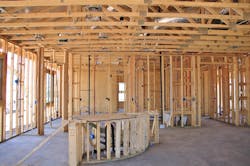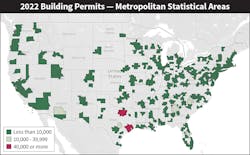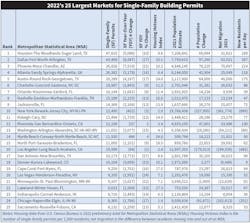Where’s the single-family housing market headed in 2023? The answer depends on your local market. The business climate for the residential construction market varies drastically on a metro-by-metro basis because of building lot availability and local building, water, or environmental regulations, and the underlying demand for starter homes, larger single-family homes, apartments or condos, and senior living developments. Macroeconomic factors such as the ongoing population shift to the Sunbelt, the surge in Baby Boomer retirements, and remote officing are also huge factors. And don’t forget that home buyers are getting hit with the highest mortgage rates they have seen in the last few years coupled with the shortage of available entry-level homes in many markets.
Construction economists agree that the construction of single-family homes and multi-family condos or apartments will decline from 2022 before regaining traction in 2024. A post by the National Association of Home Builders (NAHB) at www.nahb.org said, “The housing recession that began in 2022 will bleed into 2023 as elevated inflation and mortgage rates, coupled with stubbornly high building material construction costs, continue to take a toll on the housing industry and are expected to push the overall economy into a mild recession this year. However, the second half of 2023 could lead to a turning point for housing and the economy.”
During a press briefing at the 2023 International Builders’ Show, Robert Dietz, NAHB’s chief economist said, “With interest rates projected to normalize in the second half of 2023 as the Federal Reserve taps the brakes in its fight against inflation, the pace of single-family construction will bottom out in the first half of 2023 and begin to improve in the latter part of the year. This forward momentum will lead to a calendar year gain for single-family starts in 2024.”
Now that the preliminary year-end building permit data for 2022 is in from the U.S. Census Bureau, we can get a good sense of which market areas will see the most home construction this year (Fig. 1). Because single-family building permits typically lead housing starts by several months, they are a dependable leading indicator of future building activity. And despite the general feeling amongst construction economists that housing starts will slide again this year before bouncing back in 2024, some local markets should see a surprising amount of housing construction in 2023. Let’s explore the key trends that will shape the residential construction market’s business climate in 2023.
Homebuilders will get some relief from price increases for key construction products, but the pricing picture will remain mixed in 2023. The good news for homebuilders is that lumber and plywood prices are down 30.8% year-over-year (YOY) in January, according to the U.S. Bureau of Labor Statistics’ Producer Price Index (PPI). However, some other key product groups were still logging increases at press-time. Plastic construction products were up 7% YOY according to the PPI, while prices for building wire and cable were up 7.7%, and residential luminaires were up 5.9% YOY, according to Electrical Marketing’s Electrical Price Index (EPI).
A handful of markets will once again see the bulk of the action. The homebuilding market is quite consolidated, with the majority of the activity in the Sunbelt or Intermountain states. The 10 largest markets (see Table below) account for 33% of all single-family building permits, while the Top 25 metros account for more than half the permits. The Top 50 metros account for an estimated 70% of all activity.
Builders in the three Texas Metropolitan Statistical Areas (MSAs) ranked in the Top 10, pulling in a crazy number of combined permits — 111,331 single-family permits. The Houston-The Woodlands-Sugar Land, TX, MSA (47,633 permits) led the state’s Big Three, followed by Dallas-Fort Worth, Arlington, TX, MSA (43,409 permits); and Austin-Round Rock-Georgetown, TX, MSA (20,289 permits). Add in San Antonio-New Braunfels, TX, MSA (10,173 permits), and these four metros alone account for more than 121,000 single-family permits. These four Texas MSAs together had more single-family permits than any other entire state except for Florida, which had 133,750 single-family permits for 2022.
Despite the massive number of permits builders pulled in these markets last year, many of the top markets actually experienced some sizeable declines in permit activity. While the 10 largest markets saw builders pull at least 12,000 permits through December 2022, nine of these MSAs saw YOY declines of at least 2,000 permits. It’s interesting to note that the two market areas with YOY increases in single-family building permits of more than 1,000 were actually smaller or medium-sized markets — the San Jose-Sunnyvale-Santa Clara, CA, MSA (1,294 increase) with 3,694 single-family permits, and the Punta Gorda, FL, MSA (1,202 increase) with 4,637.
While many of the Sunbelt’s larger MSAs logged some impressive permit totals last year, several smaller and medium-sized markets actually grew faster. You can use the Housing Hotness Index to compare large and small markets in terms of building activity. To level the playing field when comparing smaller market areas to the nation’s largest MSAs, this index ranks metros based on the number of single-family permits per 1,000 residents. It’s interesting to note that seven MSAs in Florida ranked in the Top 10 in the Housing Hotness Index — The Villages; Punta Gorda; North Port-Sarasota-Bradenton; Lakeland-Winter Haven; Cape Coral-Fort Myers; Naples-Marco Island; and Port St. Lucie. Rounding out the Top 10 in the Housing Hotness Index were Austin-Round Rock-Georgetown, TX; Myrtle Beach-Conway-North Myrtle Beach, SC-NC; and Provo-Orem, UT.
Tracking inbound and outbound moving trucks/population growth offers a quick read on residential building activity. You can always get a pretty good idea of where the new housing construction will be happening by watching the markets with the highest increase in population. In fact, six of the metros with the biggest increases in population between 2020 and 2021 are also among the Top 10 in building permits.
Many of these same MSAs pop up in the North American Van Lines “Moving Migration Report,” which analyzes the cities with the most inbound and outbound moving trucks (Fig. 2). The report said the top cities for in-bound migration in 2022 include: Raleigh, NC; Charleston, SC; Tampa, FL; Jacksonville, FL; Tucson, AZ; and Nashville, TN. On the flip side, the report said since 2014, Illinois has been the top state for outbound moves and that other leading outbound states include New Jersey and Pennsylvania.
Another way of measuring a market’s population growth is to look at the number of new residents moving in each day. Six MSAs are attracting more than 100 new residents each day: Dallas- Fort Worth, Arlington, TX, MSA (267); Phoenix-Mesa-Chandler, AZ, MSA (214); Houston-The Woodlands-Sugar Land, TX, MSA (189); Austin-Round Rock-Georgetown, TX, MSA (175); Riverside-San Bernardino-Ontario, CA, MSA (130); and Atlanta-Sandy Springs-Alpharetta, GA, MSA (118). The folks moving into these high-growth markets tend to be from some of the nation’s larger metropolitan areas. The two markets that suffered the largest population losses, according to U.S. Census data, were the New York-Newark-Jersey City, NY-NJ-PA, MSA, which lost 327,955 residents in 2021 (899 per day); and the Los Angeles-Long Beach-Anaheim, CA, MSA, which lost 175,913 residents (482 per day). The Chicago and San Francisco metro areas are also losing residents at an alarming rate.
Summary. Even if the single-family construction in your local market area doesn’t rank up there with the high flyers mentioned in this article, you can still track your local market with the same data sources. Become familiar with the U.S. Census Bureau’s Building Permit Survey data, available at www.census.gov/construction/bps/current.html, and the data and housing reports available for free from the National Association of Home Builders at www.nahb.org. Population data at the county, MSA, state, and national level are also available at www.census.gov. Electrical Marketing newsletter (www.electricalmarketing.com), EC&M’s sister publication, offers regular data updates on residential building activity, population growth and employment trends as part of a $99 annual subscription.
About the Author
Jim Lucy
Editor-in-Chief, Electrical Wholesaling & Electrical Marketing
Over the past 40-plus years, hundreds of Jim’s articles have been published in Electrical Wholesaling, Electrical Marketing newsletter and Electrical Construction & Maintenance magazine on topics such as electric vehicles, solar and wind development, energy-efficient lighting and local market economics. In addition to his published work, Jim regularly gives presentations on these topics to C-suite executives, industry groups and investment analysts.
He launched a new subscription-based data product for Electrical Marketing that offers electrical sales potential estimates and related market data for more than 300 metropolitan areas. In 1999, he published his first book, “The Electrical Marketer’s Survival Guide” for electrical industry executives looking for an overview of key market trends.
While managing Electrical Wholesaling’s editorial operations, Jim and the publication’s staff won several Jesse H. Neal awards for editorial excellence, the highest honor in the business press, and numerous national and regional awards from the American Society of Business Press Editors. He has a master’s degree in communications and a bachelor’s degree in journalism from Glassboro State College, Glassboro, N.J. (now Rowan University) and studied electrical design at New York University and graphic design at the School for Visual Arts.




